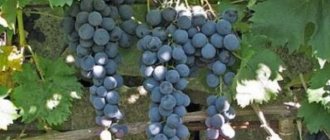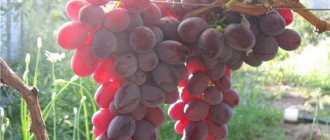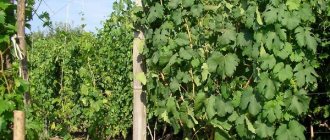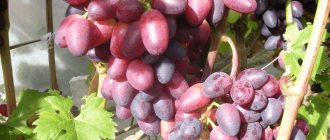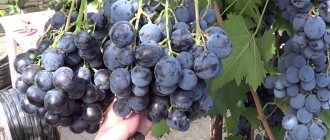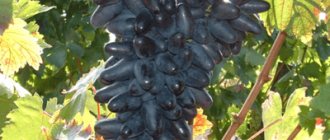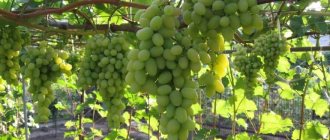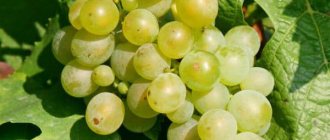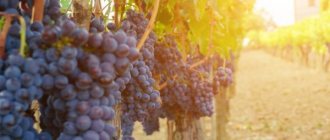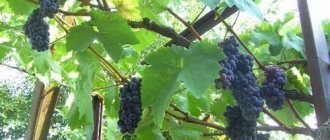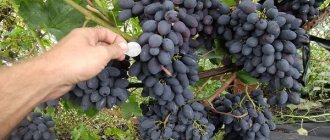History of selection
The photo above shows bunches of Blagovest grapes. This is a hybrid form. The work was carried out by V.N. Krainov. For hybridization, an amateur breeder took the well-known varieties Kishmish Radiant and Talisman. Vladimir Nikolaevich’s vineyard was located in the floodplain of the Tuzlov River (Rostov region). To avoid phylloxera, the national breeder used only resistant rootstocks Kober 5BB, CO4.
Work on hybridization began in 1995 and continued for several years. The first harvest was taken in 1999. The variety was not included in the State Register. Amateur winegrowers appreciated the yield of the variety. Blagovest has taken root in many vineyards.
Reviews and videos
Ksenia Vasilievna, 34 years old, Belgorod
We planted these grapes at our dacha several years ago. It suits me and all my relatives quite well. I didn’t notice any significant defects in it, but its advantages are obvious: it ripens quickly, produces dense, heavy brushes. The taste of the berries is, as it should be, sweet, with a slight nutmeg sensation. I recommend everyone to plant at least one bush of this variety.
Vladimir Anatolyevich, 53 years old, Izobilny
I have been growing Blagovest grapes for many years. I chose it for its early ripening, disease resistance, high fertility, and also because I like white grapes. Its clusters are always large, not loose, neat and very edible in appearance. If you plant these grapes on your plot, you won’t be disappointed, check.
Description of Blagovest grapes
Blagovest grape bushes have great growth power. Many fruitful shoots are formed. The vine ripens well. There are no problems with pollination. Self-pollinating, table variety. Female and male flowers are formed and appear in the first half of June.
The density of the bunch depends on the load of the bush. Can be loose or dense. Main characteristics of a bunch of Blagovest grapes:
- shape elongated-conical, rarely round-cylindrical;
- average weight – 0.8-1.2 kg;
- maximum weight – 2-3 kg;
- size is large.
Blagovest grapes have marketable berries. They are large, oval or oval-papillary. The color of ripe fruits is milky green, pale green, green-yellow. The color depends on the degree of illumination of the bunch. On the side facing the sun, the berries are almost amber.
The average fruit weight is 12-15 g. They are covered with thick skin. The seed size is small, the pulp structure is dense, and the percentage of juice is high. Sugar content is high. The taste is original. It contains bright notes of nutmeg and duchess. The harvest has a table purpose. It is consumed fresh and used in home winemaking. The Blagovest variety sells well on the market.
Appearance of the plant
This variety was bred by the Gavrish agricultural company and is intended for cultivation in greenhouses, which makes it popular for residents of regions with cold climates. Tomato Blagovest belongs to the hybrids of the determinant type.
Reference. The word “determinant” is translated as “limited.” Tomatoes of this type stop growing at a certain point. This is easy to notice - if a fruit cluster appears at the top of the stem, then the bush will no longer grow in height.
For those who decided to try growing Blagovest for the first time, we offer a detailed description of this tomato.
The height of the bush reaches 1.7 m, the thickness of the stems is 1.2-1.7 cm, and they have a medium leaf cover. You can grow it in one or two stems, each of which produces 5-7 clusters. The color of the stems and leaves is dark green with a grayish tint.
The yellow flowers come in groups of 10-12, but only 7-10 fruits will set. The harvest can be harvested in about 100 days.
Characteristic features of the variety
The specificity of the Blagovest grape variety is the formation of a large number of inflorescences on one fruiting shoot. There are 3-4 of them formed, as can be seen in the photo of the grapes. The description states that bushes under 5 years of age cannot bear such a load. Experienced winegrowers carry out mandatory rationing of Blagovest vines.
Advice! On one fruiting shoot you need to leave one flower cluster, choose the largest one.
Even in the same climate zone, reviews about the ripening time of this grape variety may differ. They directly depend on the load of the bush. For the Blagovest bush that blooms for the first time, no more than 2 inflorescences are left. In the first year of fruiting, 1-2 signal clusters are produced.
Drought resistance, frost resistance
In the description of the variety, the general frost resistance of Blagovest grapes is estimated at -22 °C. This is the average. Weather disasters reduce this characteristic:
- frequent and prolonged thaws;
- the sudden onset of winter.
Despite the good frost resistance of the variety, Blagovest grapes are covered for the winter. The powerful root system of an adult bush is capable of providing the aboveground part of Blagovest grapes with adequate nutrition even during periods of drought. Young plants need regular watering.
Fruiting, productivity
The first bunches of Blagovest grapes begin to ripen in mid-July, the period of full ripening occurs in the 2nd decade of August. Table variety, medium early in terms of ripening (115-120 days). Ripe bunches can remain on the hand for a long time. The percentage of sugars in the pulp increases.
Crops are often damaged by wasps. During prolonged rains, cracking of the berries is observed. Due to improper loading of the bush, peas may ripen and individual fruits in the bunch may not ripen. The Blagovest variety, with good agricultural technology, shows consistently high yields - 6-7 kg per bush.
Resistance to diseases and pests
The Blagovest variety has a high resistance to mildew, oidium, and gray rot. According to experts, it is 3.5-4 points. Immunity to the causative agent of gray rot is higher. To prevent oidium and mildew, it is necessary to carry out a set of preventive measures.
Crop losses occur due to wasps. The roots and above-ground parts of Blagovest grape seedlings may suffer from phylloxera. Grape aphids attack bushes growing on loose, fertile soils. In the vineyards of the Rostov region and Krasnodar region, the likelihood of Blagovest becoming infected with phylloxera is maximum. Seedlings on the Kober-55 rootstock do not suffer from grape aphids.
Advantages and disadvantages
The Blagovest grape harvest is stored for a long time in the refrigerator without losing its taste and presentation. Bunches and berries do not lose their shape during transportation. The advantages of the variety include stable yield, frost resistance, early ripening, and taste of the fruit.
Having assessed the reviews of winegrowers, we can highlight 3 main disadvantages of Blagovest grapes:
- a significant decrease in the quality of the crop due to improper loading of the bush (the bunch ripens unevenly);
- crop losses due to wasps;
- crackling of berries due to prolonged rains.
Dangerous diseases
The table hybrid Blagovest is quite resistant to most diseases and rarely succumbs to rot. There are only two common diseases that occur in this grape form - oidium and mildew. These are quite dangerous diseases for the vine that need to be treated, but it is better to take preventive measures.
Read also: What can and cannot be planted after strawberries next year
Mildew, as a rule, attacks green areas. White oily discharge becomes noticeable on the plant. Without treatment, it will quickly dry out and eventually die. To prevent this disease, it is important to choose the right place to plant the bush - an area with constant air circulation. In addition, it is necessary to monitor the growth of shoots and leaves, avoiding thickening.
If the disease does manifest itself, then you cannot do without chemicals. You can use Bordeaux mixture, which is sprayed on the plant. The solution should be 1-2%.
Another dangerous disease is oidium. It spreads to the green part of the plant, gradually capturing the bunches and berries. When infected with oidium, the berries crack and become dry. Treatment of this disease is not difficult: remove all weeds and remnants of the vine from the bush. It is necessary to ensure that the bushes are ventilated; this cannot be done without high-quality air circulation and thinning of the vines. Oidium is treated with ground or colloidal sulfur.
Landing rules
The Blagovest grape variety does not particularly like root mineral supplements. According to gardeners, the vine loses resistance to fungal diseases if you get carried away with nitrogen fertilizers. Therefore, soil preparation must be approached responsibly. Apply all necessary mineral and organic fertilizers before planting.
The table grape variety requires a high agricultural background to form large clusters and powerful growth. To fill the hole, take the top layer of garden soil. Add 2-3 buckets of completely rotted manure, 300 g of sifted ash, 300 g of superphosphate.
Comment! The distance between planting holes is at least 2 m.
A hole is dug with dimensions of 0.8 x 0.8 m. Fertilizer-enriched soil is poured onto the bottom. Prepare a seedling for planting:
- shorten the roots, dip them in clay mash;
- the strongest shoot is shortened by 2-3 buds;
- cut out the remaining shoots.
The prepared Blagovest grape seedling is placed in a hole, the roots are covered with fertile garden soil, alternating the layers of soil with layers of humus. The soil is compacted, watered abundantly, mulched with straw, rotted sawdust or black agrofibre.
Planting Blagovest tomatoes for seedlings and transplanting to a permanent place of growth
This variety is recommended to be grown in seedlings, and planting Blagovest tomato seeds for seedlings should be based on the climatic conditions of the region where the hybrid is grown - about 40-45 days should pass from the moment of planting the seeds to transplanting adult seedlings to a permanent place in the greenhouse.
Photo of planting tomatoes for seedlings
Preparing seeds and soil for planting
Since seeds are purchased annually in specialized stores, there is no need to carry out their pre-sowing preparation - this was carried out by specialists from the seed manufacturer. The only thing that summer residents usually do is germinate the seeds so that seedlings appear faster. To do this, they are placed in damp material, then placed in a container for several days until the seeds hatch. The material is regularly moistened.
Nutrient substrate for sowing tomatoes can be purchased at a specialty store, but many vegetable growers prepare it themselves at home. At the same time, they mix garden soil, compost or humus and high-moor peat in equal proportions. To make the soil more nutritious, wood ash and mineral fertilizers containing potassium and phosphorus are added to it.
On a note!
Nutrient substrate prepared at home should be disinfected before placing it in containers. To do this, you need to spill it with a weak solution of potassium permanganate.
Tomato Blagovest - video
Containers for planting Blagovest tomatoes should be low but wide. Before use, they are also washed with a solution of potassium permanganate to disinfect. They are then filled with prepared soil.
Planting seeds and further care of seedlings
Sprouted Blagovest tomato seeds are planted in furrows made in moist soil. The seed material must be buried 1-1.5 cm. Then they are sprinkled with a nutrient substrate, sprayed with a spray bottle, covered with film and put in a warm, bright place for germination.
Typically, seedlings appear 5-7 days after planting the seed. After this, the film is removed and the containers are moved to a cooler place for 5-7 days for hardening. Then the plants are returned back to the heat.
Photos of Blagovest tomato seedlings
Seedlings need 12-13 hours of daylight during growth, otherwise they will stretch out and become weaker. If necessary, seedlings are illuminated by installing fluorescent lamps nearby.
Water the growing seedlings as the soil dries. When the seedlings have at least 2 true leaves, they are planted in separate pots.
INTERESTING TO KNOW!
Top rot of tomatoes in a greenhouse
Note!
10-12 days after picking, the seedlings are fertilized with any nitrogen fertilizer. Feeding is repeated after about a couple of weeks, but no later than 12-14 days before transplanting the plants into the greenhouse.
10 days before transplanting, Blagovest tomato seedlings should be hardened off. To do this, in the first days, open a window in the room for 1-1.5 hours, gradually increasing the ventilation time, or take the seedlings out onto the balcony.
Transplantation to a permanent place
The place for planting seedlings in the greenhouse is prepared in advance. To do this, the top layer of soil is replaced with a new one, to which organic matter and mineral fertilizers must be added.
Grown Blagovest tomato seedlings are planted as follows:
no more than 3 bushes should be placed on each square of area. This allows you to achieve maximum productivity.
Aftercare
After planting, Blagovest grape seedlings are watered once every 2 weeks. Water is poured into shallow grooves (10 cm) formed around the circumference of the bush. One bush uses 4-5 buckets. In the 2nd year, the frequency of watering is increased to 4-5 times throughout the entire season.
In regions where there is a lot of snow in winter, Blagovest is not watered until the sap begins to flow. If there is a small amount of snow in the spring, 50-60 liters of water are poured under each vine. Adult plants need 3 waterings:
- the first - 20 days before the berries are fully ripened;
- the second - before leaf fall;
- the third - before frost, moisture-charging, 70 liters for each bush.
Work on crop standardization takes a lot of time. In Blagovest grapes, 3 to 4 inflorescences are formed on the fruiting shoot. Everyone doesn't leave. The quality of berries on an overloaded vine deteriorates. They become smaller, the taste changes, and the nutmeg aroma goes away.
Recommended bush load:
- eyes – 35-45 pcs.;
- shoots – 25-30 pcs.
In the fall, short pruning is carried out, leaving no more than 4-6 eyes on the shoot. If the soil was fully fertilized during planting, then mineral fertilizers are not applied for 4 years. Mulch the soil with humus. Starting from the age of 5, fertilizing is carried out annually before flowering and after harvesting.
Important! When overloaded, the quality of the embryonic inflorescences decreases. Next year's harvest suffers.
The harvest is harvested in mid-August. Before the onset of frost, the plantation is pruned and cleared of leaves and weeds. Young bushes are protected from frost. They use arcs (wire, plastic), agrospan, burlap. Holes are left at the ends for ventilation. They are closed only after the temperature reaches sub-zero.
In the spring, they rush to remove the covering structures in order to avoid early awakening of the buds, damping off of the vine, and death of the buds from high temperatures. If there is a lot of snow in winter, then the old Blagovest bushes do not cover.
